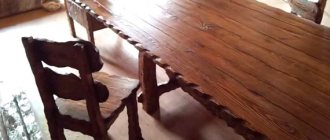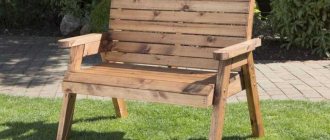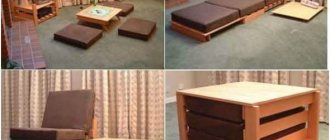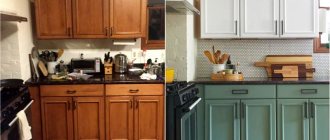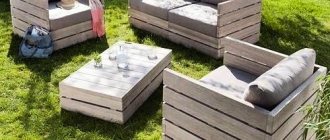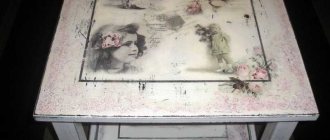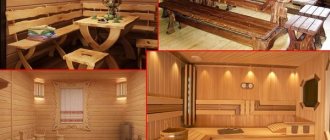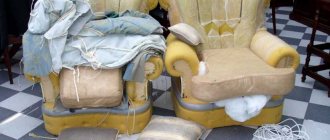The condition of the furniture deteriorates over time. Regardless of operating conditions, the finishing coating loses its strength, becomes covered with a network of small cracks, and becomes dull or cloudy.
Scratches and abrasions appear, which spoil the appearance of the furniture and make it unsuitable for use in the interior of residential or public premises. However, in most cases the condition of the surfaces can be restored, and sometimes it is possible to make the furniture more attractive than it was before.
What is polishing
Polishing is a process of finely treating a surface, giving it shine. As a rule, the varnish layer is polished, but the procedure can also be performed on the paint or the material itself. The processing technique is close to grinding, but the fineness of the abrasive in this case is an order of magnitude higher.
There are different degrees of surface gloss. There are glossy finishes that are highly shiny and reflective to surrounding objects. Furniture finished in this way looks elegant, bright, and glares when exposed to light.
Matte surfaces do not reflect light, their shine is very soft. As a rule, matte types of varnish are used for modern furniture, but ancient samples were coated with a special composition (classic shellac), or the wood was simply impregnated with oil, followed by processing with cloth swabs.
Expert opinion
Kokovin Dmitry Vasilievich
Furniture restorer
There are different polishing techniques. The basic method is to apply a special polishing paste to the prepared surface and process it using a polishing wheel made of foam rubber, felt, felt and other materials.
Is polish needed at all?
What is polish used for? The name itself suggests its purpose.
Important! Polish - give a surface a mirror appearance by rubbing.
As a rule, such products are used on varnished furniture, which is the most popular among the entire range of wooden products. Although they are also used to care for unprotected wood - to even out color and texture.
What materials can be polished?
As a rule, furniture coating is a varnish layer of one composition or another. In Soviet times, the main type of coating was polyester varnish. It was applied in a thick layer (0.5-0.8 mm), ground and polished on special production lines.
Modern furniture has a varnish coating made on the basis of the same polyester. Or other materials. there are many of them, but the general properties are approximately the same.
The most common coatings are:
- polyester;
- polyurethane;
- nitrocellulose;
- impregnation with oil of natural or synthetic origin.
Almost all varieties can be polished. The softer the varnish, the easier it is to polish, but its abrasion resistance is much lower.
Paints and varnishes that are sold in retail chains are of little use for creating high-quality furniture coatings. They do not meet standards for hardness and load resistance. For restoring furniture coverings, they are suitable only in certain cases and require proper use.
Advantages and disadvantages of polished furniture
Polished furniture requires special care, as it can easily become dirty and damaged.
Polished furniture is distinguished by its mirror shine and unique gloss, which gives it a sophisticated look. To achieve this effect, during its production all façade edges are coated with special protective resins and varnishes, after which the polishing stage occurs.
Chic antique lacquered wood table
The reflective elements of these products fit perfectly into the space, visually expanding it, and also make the room brighter. It is important that with proper care, polished interior items will serve their owner for decades.
Beautiful polished antique table
Meanwhile, it is worth paying attention to the disadvantages inherent in products with a varnish coating:
- attracts dust;
- If not properly cared for, it quickly becomes dirty;
- fades when exposed to direct sunlight for a long time or when exposed to certain chemicals;
- high probability of mechanical damage.
Polished coffee table for the living room
Methods for polishing furniture at home
Despite its apparent complexity, polishing is not a high-tech process and is quite accessible to do it yourself. Its only drawback is that it is labor intensive; the work requires care, time and effort.
Felt
Felt
The main method of polishing a new coating is to apply a polishing compound and treat the surface with felt or felt material. To obtain a mirror shine, you have to use special devices - attachments for an electric drill or grinding machines, otherwise the procedure will take too long.
Polishing technology has been known to people for a very long time. It has been improved, supplemented, and improved over thousands of years. Today, at home, you can use different techniques, which are chosen depending on the initial condition and type of coating.
Classic polishing
Ancient polishing methods differ markedly from modern ones. In practice, this is a separate technology that is rarely used today. Simultaneous application and polishing of a varnish composition or polish is carried out. This is shellac tree resin dissolved in ethyl alcohol.
The polishing process is carried out using a swab. Take a piece of clean linen cloth the size of a handkerchief. A lump of cotton wool the size of a large plum is placed inside. A little polish is poured into it, wrapped in a cloth and the surface begins to be processed in a circular motion.
The composition impregnates the tampon and fabric and is applied in small quantities to the surface. It dries immediately on it, so you need to act quickly, without stopping. If the swab is stopped in one place, the polish will dissolve the already created layer and ruin the entire work.
Expert opinion
Kokovin Dmitry Vasilievich
Furniture restorer
Classic polishing is a complex procedure that requires experience and skill. In addition, it is very difficult to get natural shellac today, so this technique is rarely used. Basically, it is used by master restorers to restore antique furniture.
Traditional methods
Folk polishing methods are quite simple, but quite effective. As a rule, they involve treating the surface with soft materials using a fine abrasive, for example:
Dentifrice
Toothpaste
Chalk
Talc
To reduce heat due to friction, oil (sunflower, linseed or synthetic) is used. It is applied to the surface or to a polishing block, which eliminates the risk of overheating and damage to the varnish layer. To simplify the process, make a mixture of abrasive (chalk, tooth powder) and oil filler (linseed, sunflower oil).
For fittings, metal parts or hard components, only abrasive can be used, without filler. It is poured onto a felt or felt block and the surface is rubbed until shiny.
Polishing pastes or compounds
In furniture production, special compounds are used to polish the surface to a mirror finish. They are rarely found on the open market, as they are supplied in large packages. It is not advisable to purchase them for household use.
However, there are effective and high-quality pastes for polishing car coatings. They are sold in small containers (1 kg, 800 g, etc.), and to treat a small area you can buy a very small amount of material.
One such composition is 3M paste, which is available in several forms:
- No. 1. Used for rough (primary) processing of surfaces after grinding. Removes small marks and abrasive marks;
- No. 2. Brings the surface to a mirror state;
- No. 3. Brings the coating to its final state and gives the surface a durable protective layer.
In addition to the basic compositions, there are intermediate ones - numbers 1.5 and 2.5. These compositions simultaneously possess the properties of lower and higher materials.
There are other polishing compounds on the market. There are hard pastes (such as GOI) that are used for polishing hard surfaces. However, most materials are made in the form of thick pastes (the consistency of sour cream or toothpaste), which are more convenient to apply and work with. They all have approximately similar qualities and allow you to effectively and quickly bring the surface to ideal condition.
Industrial polishes - are they worth buying?
Industrial polishes contain special substances that fill microcracks in the furniture surface, as a result of which the structure of the material becomes even and smooth - polished.
Today, store shelves are filled with a variety of products from different manufacturers. They, to one degree or another, make care easier, but how safe and effective they are is always up to the consumer to evaluate after purchase. This is a matter of personal choice.
Important! It is not uncommon for a manufacturer to promise water-repellent, shockproof and antistatic effects. But in the end you only get disappointment and an unpleasant aftertaste in your soul. Although, for the sake of fairness, it is worth noting that expensive means will indeed provide such a result, but cheap analogues are a game of “believe it or not.”
Furniture wax is a good alternative
You can find furniture wax on the shelves of hardware stores. This substance has been used to coat furniture for centuries. And today it ranks first in wood processing and care.
What are the advantages of using wax:
- furniture can withstand long-term loads;
- wood does not lose its texture, retaining natural warmth;
- the velvety properties of the material are preserved;
- after coating, the color of the product becomes more expressive;
- the ability to choose any tone during restoration;
- The thick consistency fits well on the surface of the wood, filling all cracks and scratches.
Flaws:
- furniture wax should be applied to clean, open-pore furniture (so that there are no paint coatings);
- a labor-intensive process when the surface is varnished (needs to be thoroughly cleaned).
Important! Furniture wax is in most cases used on freshly made furniture, or for thorough restoration of furniture products. When you need to remove a few small scratches or slightly refresh the color, it is better to use a polish with wax or silicone additives.
Wax furniture polish AMWAY™
This is the option when you can trust the manufacturer, because more than one housewife has already noted the effectiveness of this brand’s products for various purposes.
An excellent Amway polish, which has established itself as an ideal assistant for the care of wooden and lacquered furniture.
Important! The creamy aerosol spray consists of a mixture of wax and silicones. After use, the darkened wooden surface acquires its original shine and gloss, and scratches disappear.
Advantages:
- creamy structure - does not flow, does not drip;
- fresh lemon aroma - non-toxic;
- convenient aerosol can;
- easy to use.
Useful tips
Polishing is a largely creative process. However, it is better to act according to proven methods and not violate technology.
How do you polish?
ClassicFolk
It is recommended to follow some tips:
- During operation, do not apply too much force or put pressure on the machine. This may cause the coating to overheat;
- If marks or scratches are clearly visible, you should not start polishing. It is necessary to carefully prepare the surface. sometimes this is neglected, hoping that the flaws will disappear during processing. However, they will remain and will be clearly visible;
- Matte finishes do not polish. Sometimes they become covered with shiny areas, which are restored using scratch paper.
By following these simple tips, you can get high-quality coverage and avoid annoying mistakes.
Furniture polishing is a procedure that allows you to restore old products and correct errors made during operation or transportation. The polishing technology is simple, but high quality can only be achieved with skills and experience. Otherwise, the flaws in the coating will only be exacerbated. If you don’t have confidence in your abilities, it’s better to entrust the work to specialists.
Reasons for contamination of polished objects
Due to careless handling, stains appear on polished furniture.
As with any furniture, the main reason is dust settling on smooth tables, cabinets and bedside tables. But varnished surfaces not treated with antistatic agents have an increased ability to “attract” the smallest particles. Microcracks in the smooth layer also accumulate contaminants, which are difficult to remove. Therefore, the fight against dust on polished furniture is especially important.
Additional causes of pollution are:
- greasy fingerprints left after touching the polish;
- stains from any spilled liquid;
- stains from wet wiping of furniture that were not removed in time by additional polishing;
- stuck pieces of paraffin, wax or plasticine;
- traces from the impact of hot objects placed on the surface without gaskets.
In addition to dust, most pollution is created by one’s own hands as a result of negligence when handling furniture. You can avoid them by following simple rules. But we cannot rule out chance.
If stains do appear on polished furniture, you need to be able to remove them correctly without causing additional harm.
Most Beautiful
Every home has wooden furniture. This is a sign of good taste of the owner of a private cottage or apartment, and also a specific comfort, color and good quality of the environment. After reading our article, you will learn how to choose the right care products for such interior items, and you will also be able to easily make furniture polish with your own hands, so that caring for it becomes even easier, and the appearance remains unchanged. But first things first.
Stages of work
The wood polishing process consists of several stages. In order for the surface to look perfect after polishing, it must first be sanded, then covered with a layer of primer and only then thoroughly polished.
Surface grinding
This procedure does not cause any particular difficulties, but it takes a lot of time to give the tree a perfect look.
The surface must be free of chips, burrs, cracks and other defects. First, the wood is treated with sandpaper No. 46-60, then with abrasive material No. 80-100 and finally sanded with sandpaper No. 140-170.
After sanding, the wood becomes clean, smooth, without protruding fibers or lint.
Padding
At this stage, the prepared wood is primed using shellac polish and a linen swab. It is not recommended to use cotton or wool fabrics for these purposes; they leave behind small fibers and lint, which are clearly visible on the polished product.
To apply the primer, put a small amount of polish on a swab and begin rubbing in different directions. With this approach, small cracks and pores are most effectively filled, and impregnation occurs better.
The primed product is left to dry for 2-3 days. After the varnish has dried well, it is necessary to sand the wood with a fine-grained abrasive material. The resulting dust is removed with a rag.
Polishing
After priming, the so-called polishing is performed. A couple of drops of vegetable oil are applied to a tampon made of linen fabric (this facilitates easier sliding) and a little liquid shellac polish is poured. For work, you can further dilute the shellac-based composition (usually an 8% solution is used).
Place the tampon on the side and make smooth circular movements. Polishing is carried out in three passes, where each layer must dry, sand with fine-grained sandpaper and be cleaned of dust. A slight gloss can only be seen after applying the third layer of the product.
Polishing
To polish the wood, that is, to obtain the perfect shine, you should treat the surface of the wood with a fine-grained abrasive material (sandpaper) soaked in vegetable oil when the third layer of polishing is completely dry. After this, drip a little vegetable oil and polish onto the tampon.
The strength characteristics of a polished coating can be improved by applying not one, but several layers. At the end of sanding, it is recommended to treat the product with a soft cloth soaked in a solution of polish and water. Excess oil can be removed by wiping the wood with ethyl alcohol. At the same time, the surface becomes smoother.
Considering that the quality of polishing is affected by compliance with all the subtleties of the process, you should not reduce the number of layers applied and the time for their drying. Otherwise, this will lead to a deterioration in the decorative qualities of the coating.
Polishing of varnished wood must be carried out in strict accordance with the technological process; only then can you obtain the most effective, fairly durable surface with a mirror shine. If you have no experience in this area, then it is recommended to first practice on small samples and then move on to more expensive products.
How to polish a varnished wooden surface?
The final result largely depends not only on the composition and tools used, but also on the technique
It is very important to pay attention to factors such as:
- nature of movements;
- pressure force;
- dwell time between stages.
To obtain the perfect gloss, polishing is divided into three stages, each of which has its own characteristics. At the first stage, most of the irregularities are smoothed out. A disk or swab soaked in the composition is moved over the surface of the wood in short zigzag movements, returning back in a straight line. You should move continuously. Do not hold the disk with polish at any point, because with prolonged contact the polishing solution can corrode the varnish. This will create a cloudy stain that will be very difficult to remove.
After each soaking of the swab with polishing liquid, it is returned to the surface of the wood with a sliding movement. To improve glide, a few drops of linseed oil are periodically applied to the tampon.
The wood is then processed using a sander and discs of varying degrees of grain. At the very beginning, it is recommended to use a disc with a grit of 600 or 800, gradually moving to finer ones (1000, 1200, 1500). During work, do not allow the disk to become clogged with dust. Any dust that appears is immediately removed using a vacuum cleaner or lint-free cloth. When changing the disc to a smaller one, be sure to completely remove the dust from the previous one, since along with it, particles of abrasive from the disc that was previously polished remain on the wood.
When using the machine, you should choose a moderate or low speed. At high speed, the varnish heats up and begins to stick. Polyurethane and nitro varnish are especially sensitive to overheating. These varnishes are best polished at the lowest speed or by hand. Oil and acrylic varnishes withstand heat better, so the disc rotation speed can be higher.
After the first stage, it is recommended to take a week's break so that the remaining solvent disappears and the varnish dries well. Then polishing is repeated, but a less concentrated polish is used. This time the swab is moved over the surface using movements in the shape of large figure eights.
After the second drying, which takes from 7 to 10 days, final processing is carried out. It's called polishing. They go over the wood very quickly with a swab moistened with alcohol or white spirit. This manipulation helps remove polish residue from the wood, especially its oil components, which do not have time to evaporate during the drying period.
Most Beautiful
Every home has wooden furniture. This is a sign of good taste of the owner of a private cottage or apartment, and also a specific comfort, color and good quality of the environment. After reading our article, you will learn how to choose the right care products for such interior items, and you will also be able to easily make furniture polish with your own hands, so that caring for it becomes even easier, and the appearance remains unchanged. But first things first.
Cleaning becomes enjoyable
If, reading the previous lines, you recognized yourself in them, then it was not in vain that I started writing this article. If, on the contrary, you wanted to urgently come to my house to put things in order, then this article is also for you. I believe cleaning can be an enjoyable experience for everyone by applying a few simple tips.
The first thing that helped me make cleaning more bearable were principles taken from the book “The Magic of Tidying Up” by author Marie Kondo.
This book focuses on the need to get rid of unnecessary things that do not bring you benefit or joy. Now I will give a few principles told by Marie Kondo that will help bring order.
Basic Recipes
As a rule, the binder composition is prepared from two parts of stearin, seven parts of chromium oxide, one part of acetic acid. A little kerosene is also added here, just a couple of drops.
There is another interesting recipe for making car polish. Here the base is clay or beeswax. In the second case, you will need to add vegetable oil or turpentine to the product and secure it again with hot wax.
When handling a car body, it is important to always use masks and gloves. A respirator will also work. The required materials are sponges and microfiber cloths. In order to save effort and time, you can purchase a polishing machine for applying the composition.
Self-cooking
First of all, you should know that every polish must contain an abrasive substance. You also need to add a component for the binder or base, it can be liquid or silicone. To prepare an abrasive, you need to do the following. Prepare chrome-containing paint and burn about 200 grams of it using a soldering iron or flame. Ammonium dichromate can be used instead of paint. The production of the binding component occurs as follows:
Compositions for varnished wood products
Such furniture polishes belong to a separate group. The fact is that if interior items have a varnish layer, they cannot be coated with universal compounds that dry out the surface. In this case, the polishing liquid is required to create additional protection - a durable film over the varnish layer. Then direct varnishing becomes unnecessary.
Industrial
The most famous furniture polishes:
- Pronto - the product removes stains from furniture well and also masks scratches on its surface;
- Chirton is a wax-based product that effectively removes dust and dirt from the surface of wood and improves its structure;
- Emsal - quickly copes with dust, as well as water and grease stains. Due to the presence of natural oils in the polish, it refreshes the color of wood, giving it a natural shine;
- Luxus – cleans the surface of wooden furniture, giving it a neat, well-groomed appearance;
- Mebelux - designed to care for wooden surfaces, extending their service life.
These and other types of polish can be purchased at a hardware store or market.
Mebelux
Pronto
Luxus
Emsal
Chirton
Folk remedies
In addition to industrial compositions, it is permissible to coat wooden furniture with folk remedies. They also carefully care for the surface, eliminating scratches and minor damage. They are considered the best of them.
Potato tubers
To polish wood, take 1 tuber, peel it and cut it in half. To do this, it is advisable to take a large potato. Then we pass it along the wood façade that needs polishing. After this, wipe the set dry with a rag. Furniture should not be cleaned with a damp cloth or sponge, as this will remove the shine and remove the polish. Lacquered interior items cannot be cleaned with soapy water, as it will damage the surface of the product.
Cutting the potatoes
Processing the coating
Wipe with a dry cloth
Burdock oil
To restore polished furniture, you need to apply oil to a cotton swab or soft cloth, and then gently wipe the wood. Upon completion of the work, wipe the treated surface with a flannel scrap.
Choosing burdock
Wipe the surface with the composition
Vegetable oil and flour
Polish wooden furniture pieces with a mixture of flour and oil. The products need to be mixed in equal proportions and then distributed over the surface of the furniture using a rag. This product polishes the surface of scratched furniture well, which after treatment acquires a well-groomed appearance and gloss.
Combining the ingredients
Wipe the surface with the composition
Table vinegar
If the set is very dirty, it can be treated with vinegar. It will add shine to glossy furniture and disguise damage. After using vinegar, as a rule, the room needs to be ventilated so that the unpleasant smell stops “haunting” the set.
Wipe down furniture with vinegar
Ventilate the room
Sauerkraut brine
The furniture is wiped with a rag soaked in brine. The stronger the brine, the better it polishes the surface. These are not all folk methods that restore the base of wooden furniture. But such recipes are considered the most effective, they last a long time, are safe and affordable.
How to repair chips?
A chip is a significant defect that is not as easy to fix as a scratch. If a piece of wood or chipboard falls off a tabletop, drawer, or leg, you will need to restore it manually. For this we use:
- Furniture putty. It is best to use nitroester or polyester based putty. It holds much stronger than other varieties. It can even restore surfaces subject to constant stress, such as countertops and drawers. The restoration is carried out in two stages. First, apply the main layer, and after it dries, another one is applied. Excesses and irregularities are sanded with sandpaper and polished with a rag 2-3 hours after applying the putty.
- Hard wax. Suitable for restoring large chips. It is selected according to the color of the furniture; if the desired color cannot be found, take several colors and mix them. Before application, the wax is melted with a soldering iron and then sculpted onto the chipped corner. Excess wax is cleaned off with a spatula, and after hardening it is sanded. To recreate the wood pattern, furniture can be tinted with a furniture marker or paints.
- Furniture edge. If the corner edge was damaged by a chip, then after restoring the corner, it also needs to be restored. The old edge is heated with an iron and carefully removed. A new melamine tape of a suitable color is glued on top, ironing it with a hot iron.
How to get rid of it?
You can deal with defects using wax, which removes them by polishing. Pencils for car restoration have a good effect. You can also purchase special compounds designed to combat scratches on furniture.
Wax
You can get rid of scratches using wax. Procedure:
- wash and degrease the surface to be treated;
- apply a small amount of wax to a flannel cloth;
- rub the scratched area in a circular motion;
- When the wax completely fills the recess, you need to remove its remains - use a paper napkin for this.
In addition to the creamy polish, you can use a hard wax pencil designed for caring for doors and laminate floors. To ensure that the product fills the entire surface of the scratch, it is melted in a water bath.
Wax masks defects well, but after several cleanings it will be washed off and the scratch will appear on the cabinet again. To prevent this from happening, it must be sealed. To do this, use a halo-free varnish or a laminate marker. You need to select products that match the tone of the kitchen unit.
Car pencil
To get rid of scratches on kitchen furniture, you can use a car pencil. It is chosen depending on the type of damage. So, a corrector pencil will help you cope with minor defects.
A wax pencil is more resistant to moisture and allows you to get rid of deep damage. Of course, upon closer inspection the scratch will be visible, but from afar it is not noticeable and almost invisible.
Pencil paint is the most effective tool. However, it is problematic to match it to the same tone as the kitchen, but if you manage to purchase a composition identical to the color of the set, then not even a trace of the defect will remain.
To achieve the desired result, use the pencil as follows:
- Clean the kitchen from dust and dirt.
- Degrease the area around the edges and inside the scratch.
- Shake the pencil.
- Remove the cap and insert the applicator. By pressing on the rod, it is filled.
- Guide the pencil along the damage, gently pressing on the rod. During processing it will fill and become invisible.
- Remove excess product with a dry cloth. You need to start removing them right away; if you miss the moment, the composition will harden into an unsightly lump.
- Leave the product to harden for 2 days.
When the paint adheres firmly to the surface, the kitchen is polished. Pencils have their pros and cons.
Main advantages:
- versatility - they can be used on any surface;
- safety for glossy finish;
- ease of use;
- great visual effect.
However, they also have disadvantages. So, pencil-paint is not cheap. The average price is 450 rubles. Although the manufacturer promises a water-repellent effect, after some time the scratch will appear on the kitchen surface again and the treatment will have to be repeated.
Special products for furniture sets
In addition to available products, there are special compositions on sale for removing scratches from kitchen surfaces. Top 3 best products:
Furniture pencil Novator
There are products on sale in different colors. The pencil can be used to remove minor defects, chips and cracks on both glossy and wooden surfaces. Price – 60 rubles.
Restoration marker Airchimedes
It is suitable for removing scuffs and scratches on a laminate kitchen. The pencil dries quickly, does not leave smudges, adheres well to smooth surfaces and does not fade in direct sunlight. Price 180 rubles.
Retouching for furniture Master City
The product is available in a bottle with a brush. There are different colors on sale. Scratches can be removed by painting them over. Retouching is used to remove surface defects, without indentations. Price – 150 rubles.
When choosing an anti-scratch product, you need to make sure that it is suitable for treating glossy surfaces.

